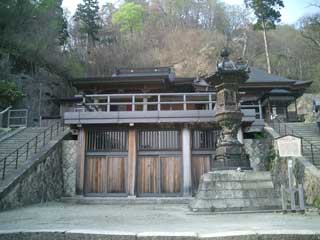Old mountain temple
![]()
Old mountain temple #1
Yamadera is an old temple in Yamagata Prefecture, Japan. The temple's official name is Risshaku-ji Temple but Yamadera is more familiar for many Japanese. Yamadera means "mountain temple". About 40 temple facilities are scattered on the slope of Mt. Houju-san, 1015 stone steps continue from the foot to the top of the mountain and the whole mountain is the precincts of the temple. The mountain and the buildings make the scenery looks like an ink painting which is very beautiful and attracts many visitors. Yamadera exactly represents what it is.
The temple starts with Kompon Chudo, the main hall. It is said that the temple was founded in 860, during the Heian Era by a high priest Ennin Jikaku-Daishi and the original main hall was built then. Over history, the hall was destroyed and rebuilt. The current building was made in 1356, in the Muromachi Period.
There is a big wooden statue of Hotei at the entrance of the main hall. Hotei is the deity of abundance and happiness. It is said that your wish will come true by touching the statue while making your wish. I touched the entire surface of the statue.
As I walked in the precincts I saw a big stone altar. It is the altar of Jizo, one of the Bodhisattvas in Buddhism. People believe that Jizo is the guardian of children and babies. The Jizo statues here are for miscarried or stillborn babies. Pinwheels and toys are offered to console their souls.
Yamadera or Risshaku-ji Temple

Statues of Basho and Sora
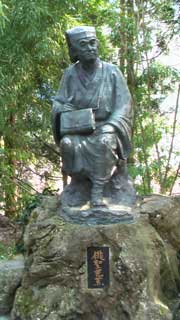

Kompon Chudo or the main hall
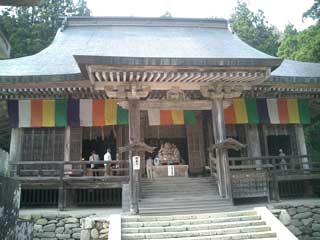
Hotei or deity of abundance and happiness

The alter of Jizo

Old mountain temple #2
I paid 300 yen at San-mon Gate and started my ascent. Soon after that, a statue with horrible face caught my eye. It was the statue of Datsueba. Datsueba is a hag who is believed to be on the bank of the Sanzu River, which lies between this world and the next. She strips the dead people of their clothes. In the old days, pilgrimages changed their clothes here and offered these clothes to the statue of Datsueba and then climbed the mountain in new garments.
The stone steps make a winding path. Surrounded by ancient Japanese cedar trees, the path was rather dim. As I climbed the steps, I saw small stone statues, lanterns and carvings on the rocks here and there. These objects and the shade of the trees made a solemn atmosphere and reminded me that Mt. Houju-san had been a sacred place, known as the mountain where the souls of the dead gather, the boundary between this world and the next.
Walking 15 minutes or so, I reached "semi-zuka" or cicada mound. It is a stone monument to commemorate Matsuo Basho, a famed haiku poet of the early Edo period (17th Century). He made a well-known haiku (3 lined poem) about cicada here.
Stillness Penetrating the rocks The cicada's cry
I visited Yamadera in the end of April when the cherry trees were in full bloom, so I did not hear the cicada's cry. There were some stones good to sit on near semi-zuka. I took a rest on a stone, imagining Matsuo Basho also took a rest here.
The statue of Datsueba

Stone statues, lanterns and carvings
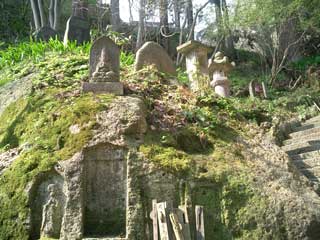


Semi-zuka or cicada mound
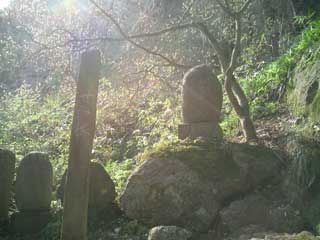
Old mountain temple #3
After passing through the Nio-mon Gate, the number of cedar trees lessened and the landscape widened. I saw many caves and odd figured rocks. I thought these caves and rocks made Mt. Houju-san special, a place leading to the different world.
Godai-do Hall is the most popular building of Yamadera. It is an observation deck that is built on the cliff, commanding a fine view. I enjoyed the splendid scenery of the mountain and the village below. Some guidebooks say there are statues of Myo-o, guardian of Buddhism in Godai-do Hall but I did not see any statues there. Instead, I saw many senjafuda or pilgrim's stickers on the wall.
After climbing 1015 stone steps, I reached Okuno-in, the top of Yamadera. Okuno-in is the building where hand-copying of sutra is practiced and statues of Buddha that Ennin Jikaku-Daishi carried are enshrined. Going up a steep path surrounded by unfamiliar objects such as carvings on the rocks and strange crags, it was like going into a different world for me. I sensed the sacred atmosphere in Yamadera, the old mountain temple.
A strange shaped rock
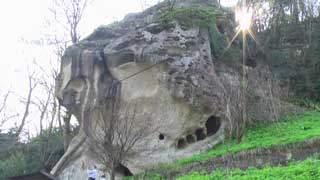
Some buildings are clinging to the steep cliff
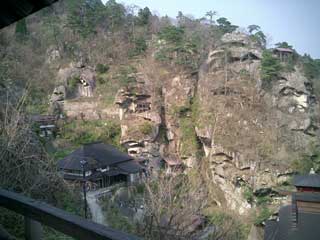
From Godai-do Hall
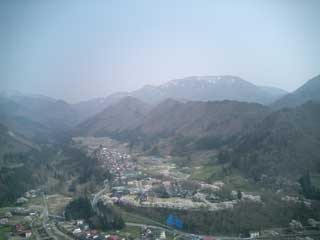
Senjafuda or pilgrim's stickers
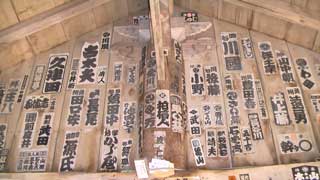
Okuno-in
